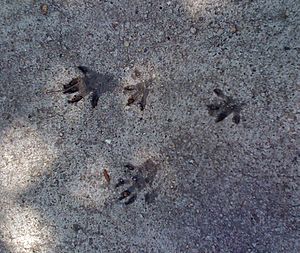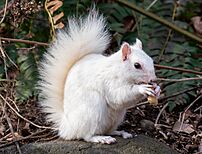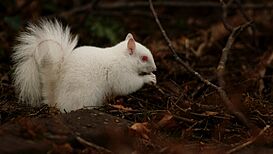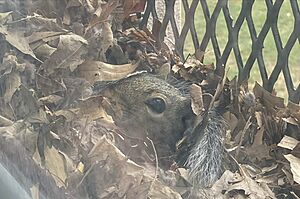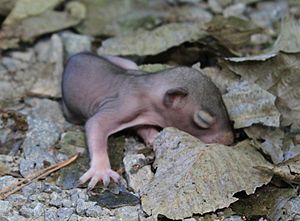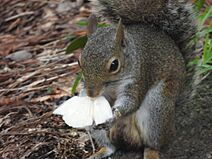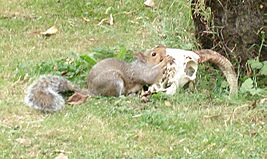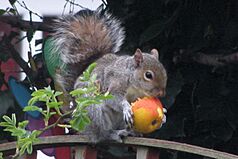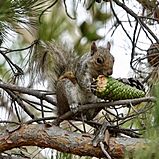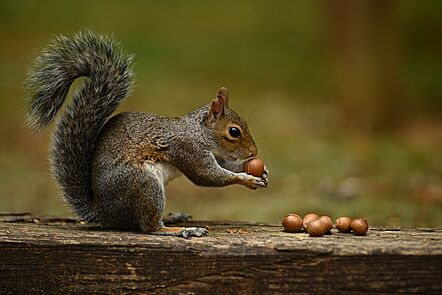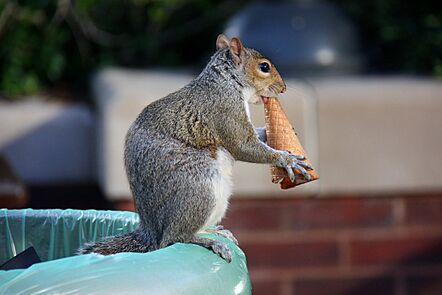Eastern gray squirrel facts for kids
Quick facts for kids Eastern gray squirrelTemporal range:
Late Pleistocene – present (18,735–0 YBP)
|
|
|---|---|
 |
|
| Conservation status | |
| Scientific classification | |
| Genus: |
Sciurus
|
| Species: |
carolinensis
|
| Subspecies | |
|
|
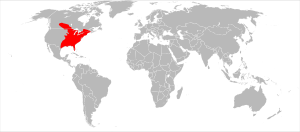 |
|
| Native range in red | |
| Synonyms | |
|
|
The eastern gray squirrel (Sciurus carolinensis) is a type of tree squirrel you can often see scampering through parks and forests. It is also known as the grey squirrel. This squirrel is originally from the eastern part of North America, where it plays an important role in helping forests grow by burying seeds.
While it is a common and welcome sight in its native home, it has been introduced to other parts of the world, like Europe. There, it is considered an invasive species because it causes problems for the local wildlife, especially the native red squirrel. Because of this, there are special rules in the European Union to stop the gray squirrel from spreading further.
Contents
- What Do They Look Like?
- Where Do Eastern Gray Squirrels Live?
- Clever Squirrel Behavior
- Life Cycle and Reproduction
- How Squirrels Talk to Each Other
- What's on the Menu?
- Predators and Staying Safe
- An Invasive Species: The Gray vs. Red Squirrel Battle
- Interesting facts about the Eastern gray squirrel
- Images for kids
- See also
What Do They Look Like?
The eastern gray squirrel is known for its gray fur, but it can also have a brownish color. Its belly is usually white. This helps tell it apart from the fox squirrel, which often has a reddish-orange belly. The most famous feature of the gray squirrel is its large, bushy tail.
Fur and Color Mutations
In cities, where there are fewer predators, you might see gray squirrels with different fur colors. Some are all black (called melanistic), and some are all white (called leucistic or albino). The black-colored squirrels are very common in parts of southeastern Canada. Scientists have found that the black fur helps these squirrels stay warmer in the cold.
Size and Shape
An adult eastern gray squirrel's head and body are about 23 to 30 cm (9 to 12 inches) long. Its tail adds another 19 to 25 cm (7.5 to 10 inches). They usually weigh between 400 and 600 grams (14 to 21 ounces). Male and female squirrels are the same size and color.
Where Do Eastern Gray Squirrels Live?
Native Home
The eastern gray squirrel is native to the eastern and midwestern United States and the southern parts of central and eastern Canada. They live in large, mature forests with plenty of nut-producing trees like oaks and hickories.
New Homes Around the World
Because they are adaptable, eastern gray squirrels now live in many places where they were brought by humans. They have been introduced to parts of the western United States, such as California, Oregon, and Washington. They were also brought to other countries, including:
- Ireland
- Great Britain
- Italy
- South Africa
In many of these new homes, they are considered an invasive species. This means they are not native to the area and their presence can harm the local environment and animals.
Clever Squirrel Behavior
Eastern gray squirrels are active during the day, especially in the morning and evening. They do not hibernate in the winter, but they may stay in their nests during very cold weather.
Storing Food
Like many squirrels, the eastern gray squirrel is a "scatter-hoarder." This means it buries food, like acorns and nuts, in many different secret spots to eat later. A single squirrel might make thousands of these caches each year! They have an excellent memory for finding where they buried their food, using landmarks to guide them.
Sometimes, if a squirrel thinks it's being watched, it will pretend to bury a nut. It will dig a hole and cover it up, but keep the nut hidden in its mouth the whole time. This clever trick helps fool other animals that might want to steal its food.
Amazing Climbers
The eastern gray squirrel is one of the few animals that can climb down a tree head-first. It does this by turning its back feet around, so the claws can grip the bark on the way down.
Nests and Homes
Eastern gray squirrels build nests called dreys. These are messy-looking balls of dry leaves and twigs, usually built in the fork of a tree's branches. Inside, the drey is lined with soft materials like moss, grass, and feathers to make it warm and cozy. Sometimes, squirrels will also make their home in a hollowed-out part of a tree trunk, which is called a den.
Life Cycle and Reproduction
Eastern gray squirrels can have babies twice a year, once in the spring and again in the summer. A mother squirrel usually gives birth to a litter of one to four babies, which are called kits or pups.
The newborn kits are tiny, weighing only about 15 grams. They are born blind, pink, and without any fur. Their eyes open after about three to six weeks, and they are ready to leave the nest when they are about 12 weeks old.
In the wild, a gray squirrel's life is full of challenges. Many do not survive their first year. An adult squirrel in the wild might live for about six years. In the safety of captivity, they can live for up to 20 years.
How Squirrels Talk to Each Other
Squirrels use a mix of sounds and body language to communicate. They can make a variety of noises, from a high-pitched squeak to a raspy chattering sound.
One of the most common ways they communicate is by flicking their tails. They use tail-flicking along with a "kuk" or "quaa" call to warn other squirrels of nearby predators, like hawks or cats. They also have a soft purring sound, called a "muk-muk," which is used between a mother and her babies.
What's on the Menu?
Eastern gray squirrels are omnivores, which means they eat both plants and animals. Their main diet includes a variety of nuts, seeds, tree buds, berries, and flowers. They especially love acorns, walnuts, and hazelnuts.
They also eat some types of forest fungi. But their diet isn't just plants. They will also eat insects, frogs, small birds, and eggs. They sometimes raid gardens for tomatoes and corn, and they are famous for visiting bird feeders to snack on sunflower seeds.
Predators and Staying Safe
Eastern gray squirrels have to watch out for many predators. Their main threats come from hawks, owls, and snakes. Other animals that hunt squirrels include weasels, raccoons, bobcats, foxes, and dogs. Their speed and agility in the trees are their best defenses. When one squirrel spots a predator, it will often make a loud warning call to alert other squirrels in the area.
An Invasive Species: The Gray vs. Red Squirrel Battle
When eastern gray squirrels were introduced to Great Britain and Ireland, they began to compete with the native Eurasian red squirrel. Unfortunately for the red squirrels, the gray squirrels have several advantages.
Why Gray Squirrels Are Winning
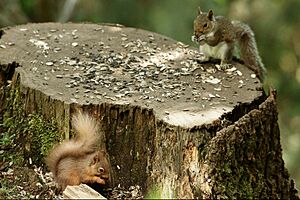
- Size and Strength: Gray squirrels are larger and stronger than red squirrels, so they can compete better for food.
- Food Storage: They are better at storing fat for the winter, which helps them survive when food is scarce.
- Disease: Gray squirrels can carry a virus called squirrelpox. This virus doesn't harm the gray squirrels, but it is deadly to red squirrels.
Because of these factors, the number of red squirrels has dropped dramatically in areas where gray squirrels have moved in. In many parts of Britain, gray squirrels have almost completely replaced the native red squirrels.
Conservation Efforts
People are now working to protect the remaining red squirrel populations. In some areas, like the Isle of Wight in England, there are special programs to remove gray squirrels. This helps give the red squirrels a safe place to live and hopefully increase their numbers.
Interesting facts about the Eastern gray squirrel
- The generic name, Sciurus, is derived from two Greek words, skia 'shadow' and oura 'tail'. This name alludes to the squirrel sitting in the shadow of its tail.
- Gray squirrels were eaten in earlier times by Native Americans and their meat is still popular with hunters across most of their range in North America.
- Their incisors grow consistently throughout life (as is true for all rodents).
- Newborn squirrels weigh 13–18 grams at birth.
- Only about one in four baby squirrels lives to be one year old. After that, their chances of survival improve.
- Diseases such as typhus, plague, and tularemia are spread by eastern gray squirrels. When bitten or exposed to bodily fluids, humans can contract these diseases.
- Males and females may share the same nest for short times during the breeding season, and during cold winter spells.
- They gnaw on bones, antlers, and turtle shells – likely as a source of minerals scarce in their normal diet.
Images for kids
See also
 In Spanish: Ardilla de las Carolinas para niños
In Spanish: Ardilla de las Carolinas para niños
- Black squirrel, a melanistic subgroup
- Western gray squirrel (Sciurus griseus)
- Arizona gray squirrel (Sciurus arizonensis)
- Mexican gray squirrel (Sciurus aureogaster)
- Tommy Tucker (squirrel), a celebrity eastern gray squirrel in the 1940s
- Pinto Bean (squirrel), a piebald eastern gray squirrel in Illinois that died in 2022
- Peanut (squirrel), an eastern gray which became famous on social media and was then controversially killed in 2024




